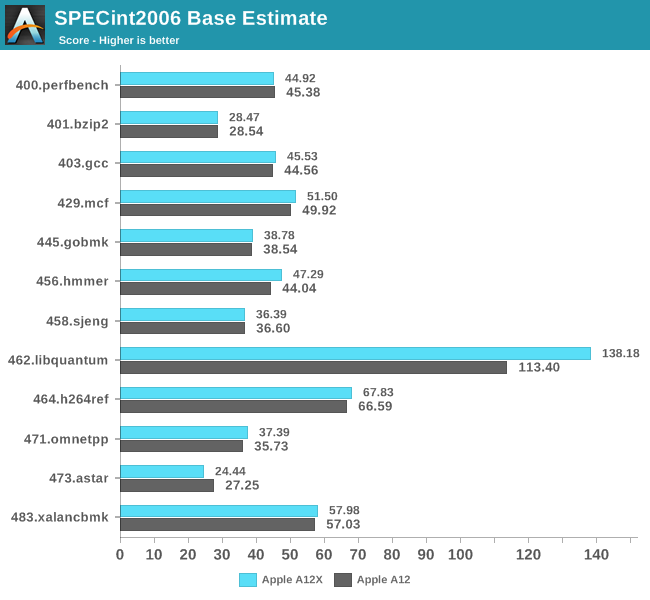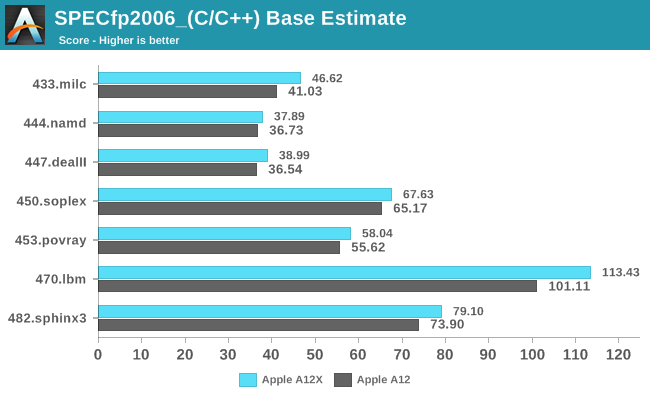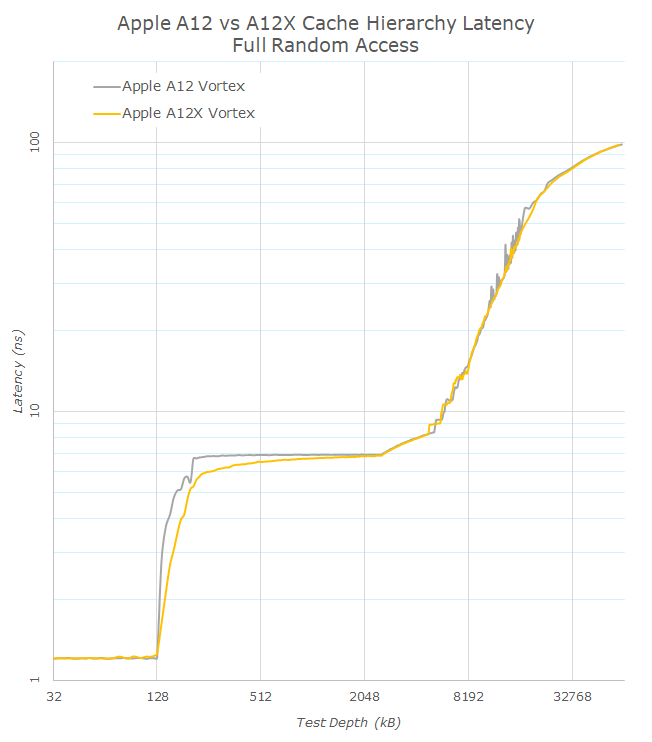The 2018 Apple iPad Pro (11-Inch) Review: Doubling Down On Performance
by Brett Howse & Andrei Frumusanu on December 4, 2018 10:00 AM ESTPowering iPad Pro: A12X
Section by Andrei Frumusanu
Apple’s new A12X SoC continues the tradition of representing an up-scaled version of the newest generation phone SoCs, in this case the A12. We’ve covered the A12 extensively in our review of the iPhone XS and XS Max, including more extensive coverage of the microarchitectural characteristics of Apple’s newest generation Vortex and Tempest cores.
The A12X, microarchitecturally, looks to be largely sharing the same generation IP blocks as the A12, with the only big difference being that the number of units has been increased in all major aspects of the SoC. Apple now for the first time employs a total of 8 CPU cores on the A12X, and compared to the A12, the figure was achieved by doubling the amount of the big Vortex cores from a dual-core to a quad-core setup. On the GPU side of things, we’ve seen the core count increase from 4 cores in the A12 to a 7-core setup in the A12X. Most important for GPU performance though – and a key aspect of the A-X series from Apple – is that the company has doubled the memory interface width 64-bit wide to 128-bit.
CPU Frequencies
In terms of CPU frequencies, Apple largely follows the same scaling pattern as on the A12, with the only difference being that there’s of course two more big cores at play. Here the A12X can support up to 8 total threads without having to resort to time-slicing their processing times.
| Maximum Frequency vs Loaded Threads Per-Core Maximum MHz |
||||||||
| Apple A12 | 1 | 2 | 3 | 4 | 5 | 6 | 7 | 8 |
| Big 1 | 2500 | 2380 | 2380 | 2380 | 2380 | 2380 | - | - |
| Big 2 | 2380 | 2380 | 2380 | 2380 | 2380 | - | - | |
| Little 1 | 1587 | 1562 | 1562 | 1538 | - | - | ||
| Little 2 | 1562 | 1562 | 1538 | - | - | |||
| Little 3 | 1562 | 1538 | - | - | ||||
| Little 4 | 1538 | - | - | |||||
| Apple A12X | 1 | 2 | 3 | 4 | 5 | 6 | 7 | 8 |
| Big 1 | 2500 | 2380 | 2325 | 2325 | 2325 | 2325 | 2325 | 2325 |
| Big 2 | 2380 | 2325 | 2325 | 2325 | 2325 | 2325 | 2325 | |
| Big 3 | 2325 | 2325 | 2325 | 2325 | 2325 | 2325 | ||
| Big 4 | 2325 | 2325 | 2325 | 2325 | 2325 | |||
| Little 1 | 1587 | 1562 | 1562 | 1538 | ||||
| Little 2 | 1562 | 1562 | 1538 | |||||
| Little 3 | 1562 | 1538 | ||||||
| Little 4 | 1538 | |||||||
On a single CPU core, the A12X clocks up to an identical 2500MHz as the A12. The similarities continue with two active big cores where the peak frequency is limited to 2380MHz. Finally, when three or four Vortex cores are active, the peak frequency on the A12X is limited to 2325MHz. The small Tempest cores see an identical frequency scaling as on the A12, with one core clocking up to 1587MHz, two to three cores at 1562MHz and finally 1538MHz when all four cores are active.
Cache Hierachy
Another way of scaling performance of a SoC is not only increasing the amount of computation blocks, but also changing aspects such as the amount of cache available to the various blocks. Let’s see if the A12X differs from the A12 in this regard:
Analysing the memory latency behaviour of the A12X and comparing it to the A12, it looks like Apple hasn’t really changed the cache configuration. The L1 caches are still at 128KB – but that was something to be expected. What is more interesting, is it seems the L2 cache also has an identical size to the A12.
The A12 L2 cache was quite unique in its behaviour in that it seemingly is of 8MB of physical size on the SoC die, however there looked to be a sort of logical partitioning in a way that a single core only has access to 6MB at fast access latencies. Furthermore in the latency graph we also see the separation of the L2 cache into two banks, with the second half of the 6MB region being slightly slower for full random access patterns.
Overall there’s a bit of a conundrum here, as we can’t really reach an accurate conclusion: Has Apple maintained the L2 cache at 8MB, or do we simply not see more of it because of a continuation of this logical partitioning? While we don’t have access to a die shot of the A12X to confirm this, I still think this is simply a case of Apple maintaining 8MB of L2 and sharing it among the four Vortex cores.
One of the A12’s big improvements was the new system level cache coming in at 8MB and employing a new microarchitecture. It looks like this part of the memory cache hierarchy has also remained unchanged as we just see minor differences in the latency behaviour past 8MB (Past the L2).
SPEC2006 Performance
We’ve extensively covered the SPEC2006 performance of the A12 in our review of the iPhone XS/XS Max and analysed the microarchitectural characteristics of the new Vortex CPU as observed in the performance results of the various SPEC workloads.
We continue the same exercise on the A12X: In general we shouldn’t expect too big variations here from the iPhone results, with the only big difference between the two SoCs being the increased memory bandwidth available to the A12X.

In SPECin2006, the A12X’s performance is pretty much in line with the A12, with the scores being pretty much within the margin of error, although the A12X ends up a percentage point or two faster than the A12 in some benchmarks.
The big outlier here is 462.libquantum: The benchmark workload here is characterised as heavily vectorised and extremely memory bandwidth intensive. Here the 21% increase could very well be attributed to the doubled memory bandwidth available to the A12X.

In SPECfp2006, a more significant amount of workloads are characterised by their memory and latency intensive nature. Here, the advantages of the A12X are more visible as we’re seeing an average 7% increase, ranging from 3% as the lowest increase in 444.namd up to more significant 14 and 12% increases in 433.milc and 470.lbm.
The overall SPEC2006 scores for the A12X are 45.95 in SPECint2006 and 58.78 in the C/C++ workloads of SPECfp2006 – representing 2% and 7% increases over the A12.
For the sake of comparison against the various existing mobile SoCs, here’s again a large graph overview comparison containing all relevant recent Arm microarchitectures.
Unfortunately for this review we weren’t able to probe the power and efficiency of the A12X – however I’m expecting figures not all too different to what we’ve published on the A12, meaning single-core active system power should be in the 3.6-4.3W range. Naturally this should be a bit higher on the A12X due to the doubled memory controller interfaces.
Overall, the A12X is a beast of a SoC and very much follows the performance of the A12. The CPU on the A12X seems pretty much the same as on the A12 – with slight performance increases in workloads that more heavily stress the memory subsystem, here the doubled memory bandwidth helps the A12X to rise above the A12.












145 Comments
View All Comments
tipoo - Tuesday, December 4, 2018 - link
16nm did substantially cut its power use, and 16nm was less of a node leap than 7 (iirc it was closer to 22nm, but one of the finfett rebrandings?)Xbox One S 35-90
Xbox One 70-120
http://energyusecalculator.com/electricity_gamecon...
PeachNCream - Tuesday, December 4, 2018 - link
Yup, that is an impressively quick bit of hardware hiding inside the new iPad. It doesn't speak well for a lot of hardware that soaks up a bunch more power and needs a lot more cooling to accomplish similar task. I'm hoping the A12X will be something of a kick in the proverbial pants for the rest of the chip industry to get off their behinds and deliver better performance at much lower TDP, that is both CPU and GPU companies that are inflating real TDP to comparably absurd levels while chasing incremental and insignificant increases in performance.sing_electric - Tuesday, December 4, 2018 - link
To be fair, the A12 is one of the first 7nm chips to ship. AMD's Ryzen 2700U, in theory, is at least as powerful, but is built on a 12nm process so it consumes more power.A year from now, its very likely that AMD will have a mobile Ryzen built on the 7nm same process at the same foundry (TSMC) as Apple, which has the possibility of being more powerful at the same power consumption depending on workload (again, AMD and Apple optimize for different things in their chips, and an.... Apple to oranges comparison is hard to make).
Within a couple years, we'll see how Intel's new GPU unit does - they've committed to releasing dGPUs but you'd have to think that a side effect would be increased performance of their iGPUs as well. IF they're finally able to start mass-manufacturing on their 10nm (and future) process, they should be competitive as well.
Spunjji - Wednesday, December 5, 2018 - link
+1 to this. Very interested in what Intel can do at low TDPs given their experience there. UHD620 is an old architecture now, so you have to wonder what all the intervening development will grant their first real next-gen GPU.AMD have been struggling of late but it sounds like, if they coalesce their development around Navi, they should see some serious benefits at low TDPs too.
GruenSein - Tuesday, December 4, 2018 - link
I actually considered buying the new iPad Pro but as long as iOS and its and 3rd party apps keep working the way they are working, all that performance is wasted IMHO. For the device to be really productive, a real file browser and full access to files is required. Let me organize my files the way, I want. The share button and weird iCloud browser doesn't cut it. Professional workflows require multiple apps to work on the same files, so, as antiquated as Apple wants to make it feel, an "open with" and "save as"-Dialog is crucial. Same goes for file access and network integration. Why can't I access SMB-shares? Most iOS users I know still send files per eMail because that is still the most convenient way to do it. The 3rd party file browsers can help but it is still hardly possible to use these files in any other apps. Some actually start a streaming server if you want to play media with VLC because you cannot tell the app to simply open the file.From my point of view, the hardware is great and way ahead of the competition. But the software is keeping it at a toy level for the time being.
melgross - Tuesday, December 4, 2018 - link
Well, far from a toy level, which you would know if you used one. But you’re right that some things are just not available, or not up to snuff. Apple was expected to make major changes to iOS this year for the iPad Pro, but held off until next year due to the rwoerking of the OS for efficiency so that older devices would work better, as well as more modularizing the OS and getting rid of some higher level bugs.I hope these expected changes to the Desktop next year not only involve the look and function of the Desktop, but also full use of the USB port for mass storage and hierarchical folders.
Apple seems to be moving in the right direction, but more slowly than I would like.
sing_electric - Tuesday, December 4, 2018 - link
At this point, I'll believe it when I see it. Adobe had to get very creative with handling files on iOS to bring real Photoshop to the iPad, and they've got the "benefit" of their own cloud platform that they've foist on all their current customers.And lack of pointer support is getting harder to stomach - its annoying for pro-users with a keyboard, and it ALSO really limits the ability of people who use assistive communication devices to use iOS AT ALL since a lot of them work via mouse drivers. You'd think adding decent mouse support would be like, a weekend project for a team of engineers.
melgross - Tuesday, December 4, 2018 - link
Adobe ran that file at the presentation while it was residing on the iPad. You can’t do that from the cloud. That’s storage, not live functioning in the app. It doesn’t matter how they did it on the iPad. The fact is that they did, and it was very impressive indeed.Pointer support isn’t a matter of a team of engineers. It’s a matter of philosophy. Apple, at this time, still doesn’t believe in it. I don’t happen to agree with their stance. With the original 9.7” iPads, sure, but not for the bigger Pro models. So I agree there.
But even without it, things work dine in most cases. Would I want to write a novel 9n it? No, but I can get away with several pages of writing.
iOS is praised for its ability with assisted communications. Not as good as the Mac, but better than Android by a long shot.
I’m happy to see what happens in the developers conference next June. We should have a good idea where their going then. If nothing much happens, I’d be surprised. I don’t expect everything I want, but some of it.
MonkeyPaw - Tuesday, December 4, 2018 - link
Yeah, mouse support is probably a toggle away in their development process. Anyway, Affinity Photo for iOS is impressive, with both cloud and local storage options. Local photos much be handled through iOS Photos, and traditional file management must be through the files app/cloud service of your choosing. Not as many options as a desktop, but there are at least some options.KPOM - Tuesday, December 4, 2018 - link
Mouse support is a double-edged sword. It would make some things easier but also make other things harder, particularly if apps “expect” a cursor.